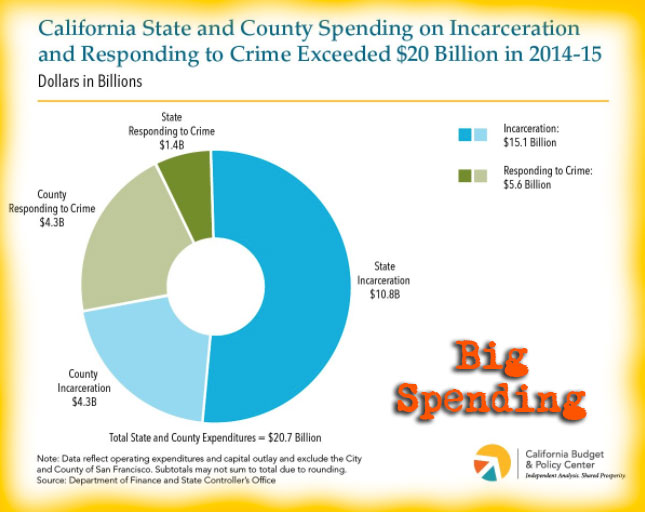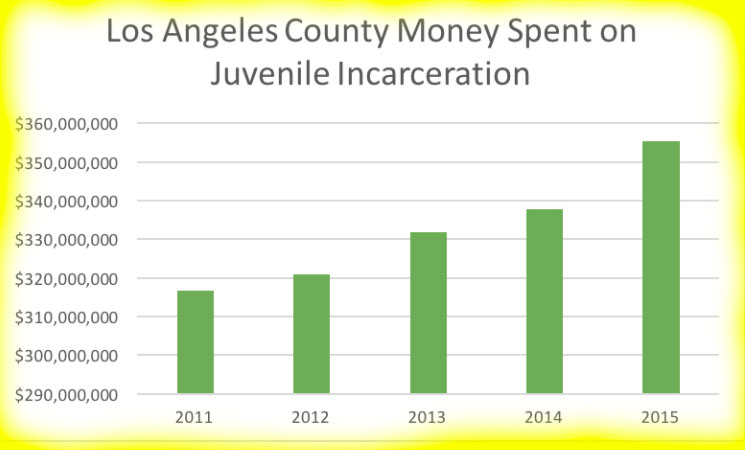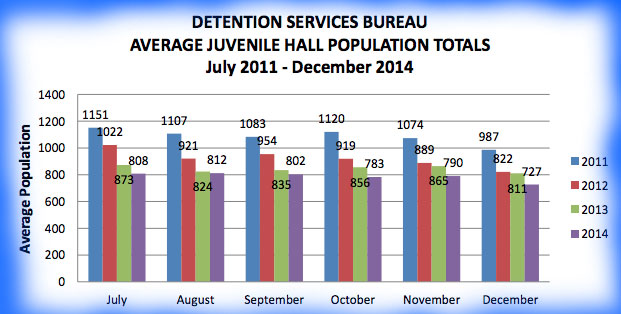EDITOR’S NOTE:
In the story below, reporter Jeremy Loudenback, the Child Trauma Editor for the Chronicle of Social Change, takes a look at a recently released report that reveals discouraging data on California and its counties’ level of spending last year on incarceration and other costs related to responding to crime. Despite reforms that reduced the California prison population, half of the $20.7 billion spent at the state and county levels during fiscal year 2014-2015 was funneled into incarcerating people in state prisons.
REPORT REVEALS CALIFORNIA IS PUMPING BIG MONEY INTO INCARCERATION AND RESPONDING TO CRIME
by Jeremy Loudenback
A new report lays out a stunning price tag for the cost of crime in California last year: nearly $21 billion.
Even as the state has launched criminal justice reforms in recent years aimed at reducing its prison population, California’s expenses related to responding to crime and incarceration have continued to rise to an all-time high for the state.
The tally comes from a new report from the California Budget and Policy Center, a nonprofit that seeks to provide nonpartisan evaluation of state budget and tax policies.
Using publicly available data from the Department of Finance and the state controller’s office, the report found that 73 percent of the total — or $15.1 billion — was spent on the incarceration of adults and juveniles at both the county and state levels.
The remaining $5.6 billion was spent on activities related to responding to crime. This includes money for trial courts as well as county spending on the prosecution of cases through the district attorney offices, probation, public defenders, some court activities at the county level, juvenile wards of the court, grand juries and associated capital outlay.
The number did not include the cost of law enforcement because some police work can be considered preventative, according to Chris Hoene, executive director of the California Budget and Policy Center.
Hoene called the $20.7 billion an indictment of California’s priorities. By contrast, the state spends around $8 billion on the University of California system, the California State University system and the California Student Aid Commission, which provides financial aid to California students pursuing higher education.
“We’ve been through several decades of an experiment of being as tough on crime as possible by throwing the book at people and locking them up for as long as possible, and we don’t have enough evidence showing it had a large public safety benefit,” Hoene said. “But there’s loads of evidence showing that it’s been very costly and had real trade-offs in terms of how we can otherwise spend those dollars and have positive impacts on our communities.”
Hoene estimated that a billion dollars across the state was spent on incarcerating juveniles last year.
In Los Angeles County, spending on juvenile detention — costs related to the incarceration of juveniles at the county’s system of juvenile camps and halls, but not including money spent on the Probation Department — topped $355 million last year.
Hoene said the money spent on youth in the juvenile justice system across the state, including incarceration, court costs and probation officers, should prompt a re-evaluation of spending patterns.
“With juveniles in particular, that level of spending calls into question what our priorities are and whether we be better spending those monies on services that would improve outcomes both for those juveniles and for the communities that they’re coming from,” he said.
The steep costs of addressing crime in California comes at a time when a wave of reform has scrutinized the financial and social costs of incarceration across the state. In November 2014, voters across the state approved Proposition 47, a ballot initiative that has re-classified some felony convictions as misdemeanors.
In the upcoming Nov. 8 election, the state will decide on another initiative aimed at criminal justice reform. Championed by Gov. Jerry Brown, Proposition 57 would increase opportunities for early parole for offenders convicted of certain nonviolent crimes and would task judges with the decision about whether to prosecute juveniles as adults.
Lizzie Buchen from Californians United for a Responsible Budget, a group that opposes the construction of new incarceration facilities, says that despite recent criminal justice reforms in California, she is somewhat skeptical about the state’s efforts.
In recent years, the state has authorized $2 billion in bonds for jail construction and has continued plans to replace or renovate 12 of its aging prison facilities, she said.
“With all the talk about reducing incarceration and the actuality of some reduced incarceration, we’re still funneling money into the system,” Buchen said.
“Before putting any more money into imprisonment, we need to prioritize finding ways to address these issues outside of jail, outside of prison because we know that’s what most effective and most cost-effective and what results in the better outcomes for people and their families,” Buchen said.
For further reading, Here’s a breakdown of data gathered and methodology used by the California Budget & Policy Center.
Holden Slattery contributed to the data analysis for this story, which originally appeared on the Chronicle of Social Change.




Is this the same Jeremy from Yellow Submarine? He speaks the same jibberish as the cartoon character and is simply regurgitating facts already on the public record. This blog post serves as nothing more that spew from the child advocacy community – and strongly implies that public safety and providing treatment and rehabilitation to youth is somehow a human rights violation (as is the habit of WLA). There is no context or any attempt to explain the figures in any sophisticated way whatsoever – perhaps so they can become indoctrinated by YJC then graduate from Free L.A. High School then be off to fetch their MSW from USC.